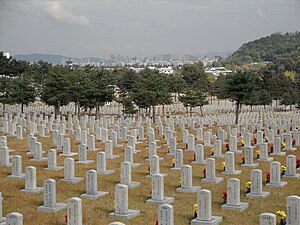The Seoul National Cemetery is located in Dongjak-dong, Dongjak-gu, Seoul, South Korea. When established by presidential decree of Syngman Rhee in 1956, it was the country's only national cemetery. An additional national cemetery was established in 1974 in Daejeon. Both are overseen by the National Memorial Board.
The cemetery is reserved for Korean veterans, including those who died in the Korean independence movement, Korean War, and Vietnam War.[1] Only one non-Korean person is buried there, the Canadian Francis Schofield.[1]
In August 2005, controversy was stirred by the visit of a North Korean delegation to the cemetery.[2] The delegation was led by Kim Ki-Nam, and numbered 182 officials. The visit not only sparked outrage among those opposed to warmer relations with the North, but also raised fears that a future delegation from the South might be expected to pay their respects to Kim Il-sung in Pyongyang.
The late president Kim Dae-Jung was interred there on Aug 23, 2009.
The Seoul National Cemetery is near Dongjak Station on Seoul Subway Line 4 or Seoul Subway Line 9. Except for some special days, normally, the Seoul National Cemetery allows access to the public.
Notable persons buried[]

Seoul National Cemetery 26th Sanctuary
- Syngman Rhee - President of Korea - buried 1965
- Park Chung-hee - President of Korea - buried 1979
- Yuk Young-soo - wife of President Park - buried 1974
- Kim Dae-jung - President of Korea - buried 2009
- Park Tae-joon - Founder of POSCO - buried 2011
Notes[]
- . ^ The Dawn of Modern Korea 236: Candid Camera, Korea Times online 24 October 2004. Retrieved 9 January 2006.
- . ^ N.Korean National Cemetery Visit Sparks Concern, Digital Chosun 14 August 2005. Retrieved 9 January 2006.
See also[]
- History of South Korea
- Kumsusan Palace of the Sun – in North Korea
- List of Korea-related topics
- List of national cemeteries by country
- Revolutionary Martyrs' Cemetery – in North Korea
- Patriotic Martyrs' Cemetery – in North Korea
- United Nations Memorial Cemetery in Busan
- War Memorial of Korea – in Seoul
References[]
External links[]
| Wikimedia Commons has media related to Seoul National Cemetery. |
The original article can be found at Seoul National Cemetery and the edit history here.